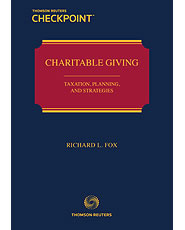We're available Monday to Friday from 8 a.m. to 6 p.m. eastern time.
Need help right now? Call 1-800-431-9025.


Contact Your Account Manager to learn more about our Checkpoint online solutions
Charitable Giving: Taxation, Planning, and Strategies is an indispensable tool that provides the specialized tax-planning insight you need to help your donor clients realize the greatest possible tax benefits from charitable giving.
Charitable Giving: Taxation, Planning, and Strategies provides detailed review and analysis of all tax aspects of charitable giving, including the most recent legislative changes. Its coverage of the Pension Protection Act of 2006 examines provisions affecting donor-advised funds, supporting organizations, private foundations, and substantiation of charitable contributions and appraisal rules.
This treatise provides new, detailed information regarding the use of retirement plans to fund testamentary and lifetime charitable giving, and it contains a multitude of forms and documents to implement charitable giving vehicles.
In addition to offering comprehensive review and analysis of the generation-skipping transfer tax, Charitable Giving devotes more than 300 pages to the rules and planning opportunities for charitable remainder trusts. This all-new edition also addresses planning issues for contributions subject to donor control, as well as planning possibilities and rules in connection with contributions to foreign charities.
Charitable Giving: Taxation, Planning, and Strategies is kept current with twice-a-year supplements and also includes quarterly bulletins addressing the latest trends and planning issues in charitable giving and philanthropy.